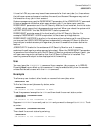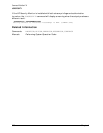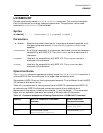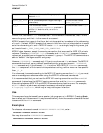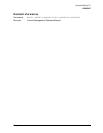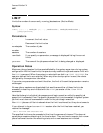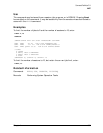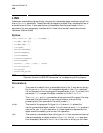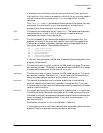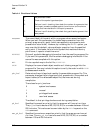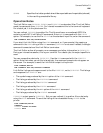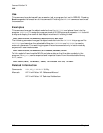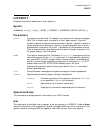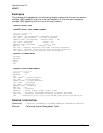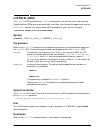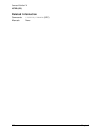
Chapter 4 315
Command Definition F-K
LINK
If a module from one library calls a routine in another library and then
that routine in turn refers to a module in the first library, you may need to
include the first library twice so that LINK can resolve this “circular“
reference.
The FROM=, RL=, and XL= parameters allow a series of file names. You may
name each file individually, or you may provide an indirect file by
preceding that file's name with the caret symbol (^).
xlfile The name of an executable library (type NMXL). The loader searches every
executable library in the XL list in an attempt to resolve external
references that remain in a program file.
caplist The list of capability attributes to be assigned to the program file. The
program runs only if the group and account have matching capabilities.
(The system manager or account manager assigns these capabilities to
your group and account.) Permissible values are:
BA = Local Batch Access
IA = Interactive Access
PM = Privileged Mode
MR = Multiple RINs
DS = Extra Data Segments
PH = Process Handling
If you omit this parameter, the BA and IA capabilities are assigned to the
program file by default.
nmstacksize The maximum size, in bytes, to which the NM stack may grow. This must
be a decimal number. The default is zero, which instructs MPE/iX to assign
a system-defined constant as the value of nmstacksize.
nmheapsize The maximum size, in bytes, to which the NM heap may grow. This must
be a decimal number. The default is -1, which instructs the command to
assign a system-defined constant as the value of nmheapsize.
unsatname The name of a procedure that the loader substitutes in place of any
external reference that cannot be resolved in a program file. If you omit
this parameter and any external references remain unresolved, the loader
reports a load-time error.
checklevel An integer specifying the maximum level of checking that LINK performs
in binding external references to procedures. All checking levels that are
indicated in external references and procedure definitions are reduced (but
never increased) to the specified level. If you omit this parameter, LINK
sets the value to 3.
Permissible values for checklevel are defined in Table 4-4.
If the checking level is restricted (reduced) and reportable type errors are
detected, they are reported not as errors but as warnings.



